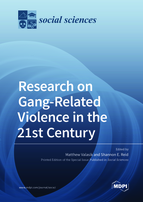Research on Gang-Related Violence in the 21st Century
A special issue of Social Sciences (ISSN 2076-0760).
Deadline for manuscript submissions: closed (15 December 2020) | Viewed by 56393
Special Issue Editors
Interests: the socio-spatial dynamics of gang behavior; effective strategies aimed at reducing neighborhood violence and discouraging gang activity
Special Issues, Collections and Topics in MDPI journals
Interests: street gangs; white power youth; crime; violence
Special Issues, Collections and Topics in MDPI journals
Special Issue Information
Dear colleague,
Conflict, including the threat or fear of potential violence, or being witness to or a victim of physical, violence, constantly surrounds gangs and their communities and is the principal driver sustaining gang life. Much of the conventional gang-related research remains focused on this violence as a neighborhood-based phenomenon that directly impacts local community residents; however, the ubiquity of digital technology, particularly social media platforms, has disrupted this traditional dynamic. Online violence, including threats, taunts, or posting of violent acts that have taken place, is much less understood. This knowledge gap includes the link between the online activities of gang members and how it can manifest into real-world action. This Special Issue will examine the diverse nature of gang-related violence with the goal of better understanding the growing complexities of gang violence over the last two decades to better inform public policy solutions. Given the dynamic nature of gang-related violence today, we aim to include empirical and theoretical research (quantitative, qualitative, or mixed-methods) with multi/interdisciplinary perspectives from around the world that highlights cutting-edge approaches to examining gang-related violence. All submissions will be considered; however primary consideration will be given to manuscripts that
- Investigate the relationship between online activity and real-world violence;
- Examine the efficacy of gang-related violence interventions;
- Conduct multi-site comparisons of gang-related violence;
- Conduct cross-cultural studies of gang-related violence;
- Describe innovative approaches to advance our understanding of gang-related violence.
Dr. Shannon E. Reid
Guest Editors
Manuscript Submission Information
Manuscripts should be submitted online at www.mdpi.com by registering and logging in to this website. Once you are registered, click here to go to the submission form. Manuscripts can be submitted until the deadline. All submissions that pass pre-check are peer-reviewed. Accepted papers will be published continuously in the journal (as soon as accepted) and will be listed together on the special issue website. Research articles, review articles as well as short communications are invited. For planned papers, a title and short abstract (about 100 words) can be sent to the Editorial Office for announcement on this website.
Submitted manuscripts should not have been published previously, nor be under consideration for publication elsewhere (except conference proceedings papers). All manuscripts are thoroughly refereed through a double-blind peer-review process. A guide for authors and other relevant information for submission of manuscripts is available on the Instructions for Authors page. Social Sciences is an international peer-reviewed open access monthly journal published by MDPI.
Please visit the Instructions for Authors page before submitting a manuscript. The Article Processing Charge (APC) for publication in this open access journal is 1800 CHF (Swiss Francs). Submitted papers should be well formatted and use good English. Authors may use MDPI's English editing service prior to publication or during author revisions.
Keywords
- gangs
- violence
- homicide
- guns
- conflict
- youth
- social media
- neighborhood effects
- intervention
- public policy







